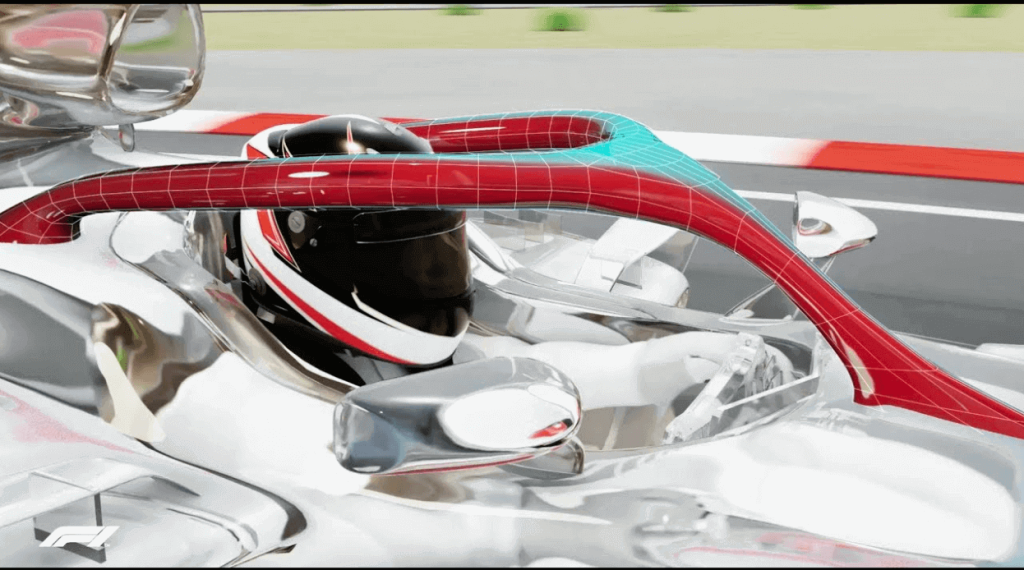“What is the halo in F1?” is a question many new and returning fans ask themselves once they see that the modern Formula 1 cars look drastically different than their precursors.
In essence, the halo is a crash-protection system that can sustain immense weight and takes the form of a curved bar placed in front and on top of the driver’s helmet.
Below we tell you why, how, and when it came to be!
What Is Halo in F1?

The Formula 1 halo is the latest and most significant advancement in the area of driver safety in the sport’s history, as it has protected numerous F1 drivers from anything from loose debris entering their cockpit to vehicle rollovers and horrifying crashes.
Constructed from Grade 5 titanium, this wishbone-shaped protection device is the car’s strongest part and can withstand the weight of a bus, despite weighing only 9 kg.
When Was the Halo Introduced in F1?
Instigated by the latest (and hopefully last) deadly crash in F1—Jules Bianchi’s fatal accident at Suzuka in 2014—the governing organization decided to take action to protect drivers from severe head trauma, which was the cause of Bianchi’s and other drivers’ deaths.
First trialed in 2016 (a year after Jules succumbed to his injuries), the halo greatly reduced the risk of injuries as it successfully protected the driver in three scenarios: collisions between vehicles, contact with debris, and impact with the environment.
After a subsequent round of tests in July 2017, the FIA deemed the halo ready for full-time use starting with the 2018 season, when it was made mandatory on every car across their Formula divisions, including F1, F2, F3, F4, and Formula E.
Note: The halo is built by three FIA-approved manufacturers, and it costs around £12,000—a fraction of the total F1 car cost of about £15 million.
You might also be interested in: How long is an F1 race?
Does the F1 Halo Obstruct Vision?
Since the halo is constructed from titanium, manufacturers are able to design thinner bars.
Moreover, the top horizontal bar is placed outside the driver’s peripheral vision, whereas the front vertical bar is inconspicuous when looking ahead.
In addition to providing an unobstructed view, the halo was the only protective system out of all proposed solutions that successfully deflected a wheel launched at it at 250 kph.
Why Was the Halo Controversial?

While F1 continuously innovates in cutting-edge vehicle technology to improve the fastest racing cars in the world, driver safety remains the sport’s main focus.
Because of that, the FIA is continuously revising its safety procedures, much to the chagrin of fans, drivers, and teams, and the F1 halo device was no exception.
The main argument against the implementation of the halo was its appearance, as opponents said it ruins the visual appeal of single-seater cars.
More sensible criticism included potential vision and movement obstruction as drivers have to see clearly and be able to get out of their cockpit fast if and when needed.
However, both arguments have since been disputed and silenced since drivers got used to the halo in F1, and it has proved to be a crucial measure in multiple crashes.
Ultimately, any new safety feature will result in better racing since drivers will gain the confidence needed to push their 1,000 hp beasts of machines to the limit.
Also, similar opposition was met with the introduction of seat belts and the F1 safety car—two essential additions that have forever changed and made the sport safer.
You might also like: Formula 1 facts and statistics
How Many Lives Has the Halo Saved in F1?

As drivers are the most important investment of any F1 team, fans, constructors, and officials always breathe a sigh of relief when they emerge unscathed from horrific crashes.
The last accident that would have resulted in a loss of life happened at the 2022 Silverstone GP when Zhou Guanyu’s car ended up in the barrier after flipping several times at high speeds.
In Zhou’s words: “I’m ok, all clear. Halo saved me today. Thanks everyone for your kind messages!”, that crash would surely have been fatal without the halo system.
However, the Formula 1 halo converted many of its harshest critics into believers during its first year when Alonso’s car landed on top of Leclerc’s at the 2018 Belgian Grand Prix and would have crushed Leclerc’s head were it not for the halo.
Incidents that took place during subsequent years cemented the status of the halo as a necessary addition to the car chassis, especially Grosjean’s 2020 Bahrain crash when he slammed into the barrier and would have been decapitated without the halo.
All in all, the halo has protected more than ten drivers from serious harm (or even death) so far—an investment that has proved its worth many times over.
Related: Why do F1 drivers get weighted?
Conclusion
Since the implementation of the halo in F1, the early criticism regarding its visual appeal has quieted down when its contribution to overall driver safety was made evident.
Additionally, fans are now treated with faster and more interesting races as drivers feel comfortable pushing to the limit, knowing they are well protected by the F1 halo device.
FAQ:
Who invented the F1 halo?
The initial version of the modern halo system was proposed by Mercedes when several F1 teams were asked to devise a head protection device after Bianchi’s crash.
Do F1 teams have to use the halo?
Yes, without exception. Every car manufacturer in FIA-sanctioned open-cockpit car racing series must implement the halo in the vehicle chassis.
Does the halo save lives?
After learning what is the halo in F1, fans understand that it has been instrumental in preventing serious injuries and even deaths, making it an absolutely necessary car safety addition.

